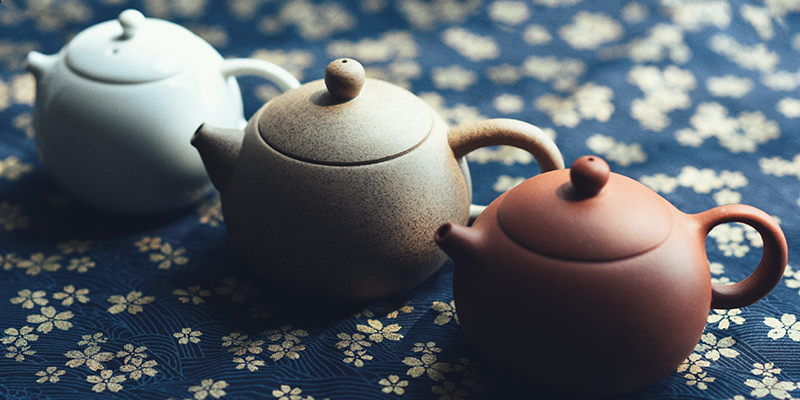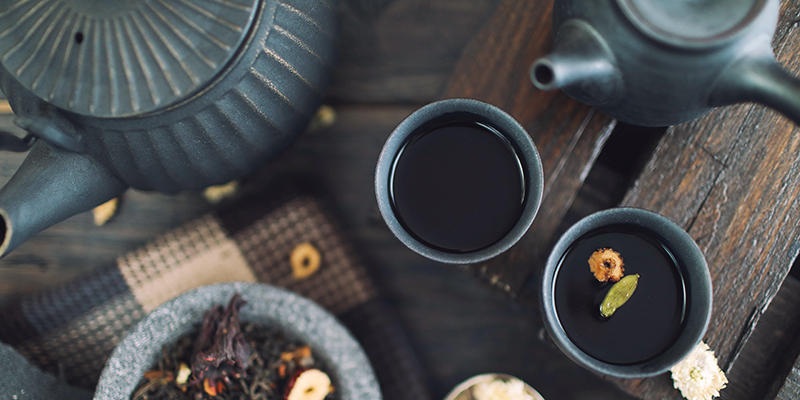Here in New England, we’ve adapted begrudgingly to these cold winter months. It takes constant creativity, energy, and resilience to find ways to brighten our early evenings.
Not far into the season, sometimes an old craving takes hold: a steaming, earthy, aromatic cup of tea. The warmth of it blooming in your belly in front of a cold window is a special satisfaction that can’t be imitated or replaced. Minty or floral, tangy or bitter, bland or strong, there is a cup out there to soothe any soul.
First Things First: Isn’t Tea, like, a Superfood?
Look at the Nutrition Facts label for tea and you will not be impressed: no significant amount of vitamins or minerals to speak of. But as with any plant, tea contains thousands of polyphenols: plant compounds that are non-nutrients, but in the human body appear to be biologically active. Research continues to explore how these compounds may improve our health.
Tea is particularly high in catechins, which are under the flavonoid class of polyphenols. Catechins are also found in wine, pears, and apples. The entire class of flavonoids, including catechins, appear to work as antioxidants. They neutralize harmful particles called free radicals that can do damage to our cells if left alone. Catechins also may play a role in vasodilation, which can improve blood flow and blood pressure.
You May Also Like: 4 Ways to Unwind with Lavender in Your Life
Studies looking at the role of tea in more sweeping health benefits such as weight loss, cancer, or dental health are still severely limited and conflicting. They don’t serve as good evidence for any of these benefits right now.
That being said, observational data from population studies seems consistent in one thing: populations that consume more plant foods also have lower instances of chronic diseases. There could be dozens of factors also contributing to this correlation, but we know for certain that adding plant foods is one small part of long-term health and longevity.
Conclusion? Drink those plants!
1) Choose your tea leaves:
Tea leaves, whether white, green, black, or oolong, are all leaves of the same plant: Camellia sinensis. The harvests simply undergo different heating and fermentation processes: light steam with little fermentation for green leaves, and longer heat with longer fermentation and oxidation for black tea. Oolong is a blend of green and black leaves. White tea is the most minimally heated and fermented, and in particular is the younger buds of the Camellia sinensis plant.
The flavor profile, from lightest to strongest, is: white, green, oolong, black. There are many, many types and textures in between, however, because tea traditions are nearly 5,000 years old, dating back to at least 2737 B.C. (Read more about the origin of tea at the UK Tea and Infusion Association).
Some herbal teas contain no actual tea leaves at all, but a blend of flowers and other flavor components. Great chamomile, for example, will only contain chamomile flowers. Red rooibos is made from leaves of the South African Aspalathus linearis bush plant. Chai does often contain black tea leaves, buts its flavor is all in the spice combination: fennel, cardamom, licorice, cinnamon, anise, ginger, and peppercorn are all up for grabs ina chai blend.
2) Brew them properly:
To bag or not to bag? Plenty of teas come as tea bags for a super-convenient cup of tea anytime. There are also paper satchels you can purchase for your loose teas; tie off and drop in for the best of both worlds.
For a full experience, consider infusing your loose teas. Find a beautiful ceramic steeping mug that fits your personality, with a tea infuser stacked inside. The cover holds warmth and then serves as a plate for your teaspoon or removed tea leaves. You can find travel mugs with infusers in them for early morning commutes, or teapots with infusers to serve more than one. A variety of single-use stainless steel and silicone infusers are also available.
Tea houses make an art out of the water temperature at which to brew certain teas for optimal flavor. It also matters how long you allow the leaves to steep. As a general rule, catch the water just before boiling, swirl excess heat bubbles out, and then pour over leaves. Boiling water may scald the tea leaves and result in a bitter flavor.
For green and white teas, 1-2 teaspoons of leaves and 2-3 minutes steeping time should suffice. For black teas 2-3 teaspoons and 3-5 minutes. The longer you allow the teas to steep, the more tannins are released into the water making for a more bracing, astringent flavor.
Bag squeezers: Bruising the tea leaves may result in a stronger, more bitter flavor — if that’s your bag, squeeze away!
3) Enhance the sensory experience:
There are times for a pure, unadulterated cup of tea — and there are times to enjoy added flavors. For black teas, the tradition is milk and honey. For green, try a simple squeeze of lemon dropped in. Milk and lemon? Protein and acid do not play well together; expect some unpleasant chemistry.
Adding other spices, herbs, and citrus may allow additional polyphenols to seep into the tea water. Consider: ginger, orange, red grapefruit, herbs such as mint, lemongrass, basil, or sage, or spices such as cinnamon, turmeric, and clove. Care for a hot toddy to clear up some evening congestion? Black tea lightly brewed, lemon, honey, and a splash of good old bourbon.
4) Don’t forget to read your tea leaves:
Reading tea leaves is not just a class taught by Professor Sybill Trelawney; it’s a centuries-old tradition called tasseography. It originated in Britain in the 17th century. Learn how to read your tea leaves at the Tea Association of the USA, Inc.
Looking into the future is a welcome past time to take up this winter: project yourself, your family, and your friends out into a blooming April and you’ll be there in no time!
Until then — you’re welcome to join me in marking the time with cups of tea until spring.









